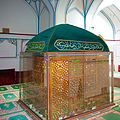Top Qs
Timeline
Chat
Perspective
Imamzadeh Ismail and Shayah Mosque
Historic Seljuk mosque and Safavid shrine in Iran From Wikipedia, the free encyclopedia
Remove ads
The Imamzadeh Ismail and Shayah Mosque (Persian: امامزاده اسماعیل و مسجد شیعه; Arabic: مسجد إشعياء ومرقد إسماعيل) is a Twelver Shi'ite imamzadeh, mausoleum, and mosque complex, located in Esfahan, in the province of Isfahan, Iran, which dates from both the Seljuk and Safavid periods.[1][2] The complex was added to the Iran National Heritage List on 6 January 1932, administered by the Cultural Heritage, Handicrafts and Tourism Organization of Iran.[3]
The original structure was a pre-Islamic building that was converted into a mosque during the Rashidun conquest of Persia.[4] During the Seljuk period, the mosque became known as Shayah Mosque.[4][2] After the Safavids had taken over Persia, they added a sahn to the structure, and built the imamzadeh.[1][4]
Remove ads
Structures
Imamzadeh
The Imamzadeh Ismail (Persian: امامزاده اسماعيل) was built around the tomb of Ismail, a grandson of the third Ahlulbayt Imam, Hasan ibn Ali.[1] Construction started in the Safavid era during the rule of Shah Abbas I, and it was completed in 1632 CE, during the rule of Safi of Persia.[4][1] The dome of the imamzadeh is decorated with tiles, and underneath the dome is Ismail's grave.[4][1] The entrance of the imamzadeh has two gilded wooden doors with very thin lines of gold on a steel background.[4][1] A hallway within the imamzadeh holds many paintings by Mohammad Saleh Esfahani.[4][5]
Mosque
The Shayah Mosque (Persian: مسجد شیعه), also known as the Shayah-Nabi Tomb (Persian: مقبره شیاح نبی),[4] is the older part of the religious complex. It dates from the Seljuk period[1][4][5] in the 11th century, and was originally built over a smaller mosque that dated from the Rashidun period.[4][1] The mosque is believed to contain the tomb of Isaiah, who is revered in Islamic tradition as a Prophet and the advisor of Hezekiah.[4][3][1] The mosque's brick minaret dates back to the Seljuk era as well, and it is 12 metres tall, but it is ruined.[4]
Remove ads
Gallery
- The purported tomb of Isaiah
- A devotee at the grave, praying to Ismail
- A painting in the imamzadeh
- The muqarnas underneath the dome of the imamzadeh
- A sign board at the Shayah Mosque, displaying the Islamic story of Isaiah and a mention of many other tombs dedicated to him throughout Iran
- One of the doors in the religious complex, with muqarnas style above the doorway
See also
References
External links
Wikiwand - on
Seamless Wikipedia browsing. On steroids.
Remove ads










